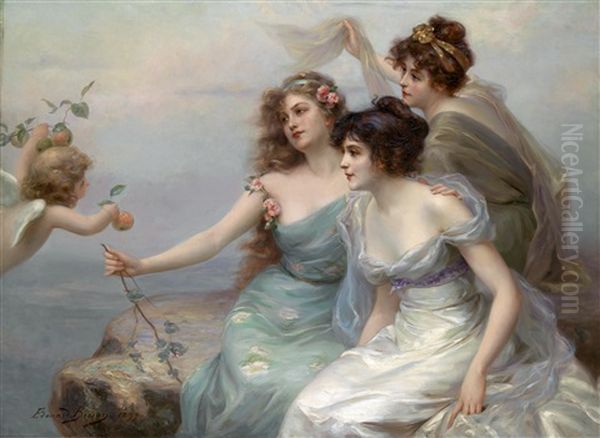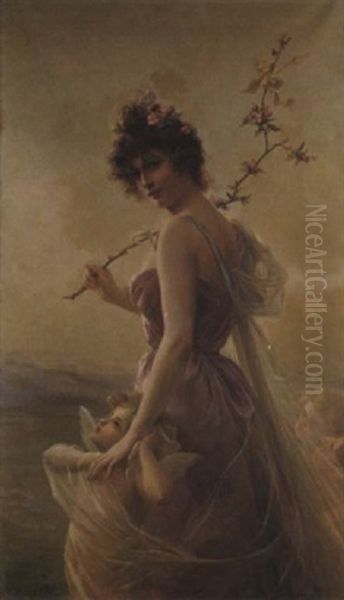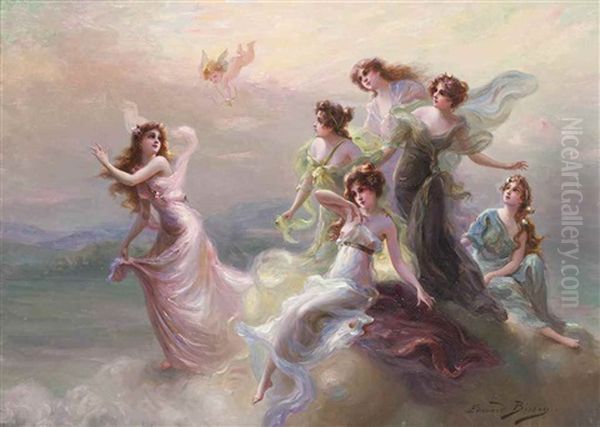Édouard Bisson (1856-1939) stands as a significant, if sometimes overlooked, figure in the landscape of late 19th and early 20th-century French art. Flourishing during the vibrant period known as La Belle Époque, Bisson carved a distinct niche for himself with his romanticized and often ethereal depictions of women. A student of the esteemed Jean-Léon Gérôme, Bisson inherited a strong academic foundation but channeled it into a more personal vision, one that resonated with the era's fascination with beauty, reverie, and a certain idealized femininity. His canvases, often imbued with a soft, atmospheric quality, transport viewers to a world of gentle grace and subtle symbolism, securing his place as a cherished Salon painter and a recipient of notable accolades, including the prestigious Legion of Honour.
Early Life and Artistic Formation under Gérôme
Born in Paris on April 6, 1856, Édouard Louis Bisson entered a world where the French capital was the undisputed center of the artistic universe. His formative years as an artist were spent under the tutelage of Jean-Léon Gérôme (1824-1904), one of the most influential academic painters of the time. Gérôme, a master of historical, mythological, and Orientalist scenes, was renowned for his meticulous draughtsmanship, polished finish, and dramatic compositions. His atelier at the École des Beaux-Arts was a magnet for aspiring artists from across the globe.
The training Bisson received from Gérôme would have been rigorous, emphasizing anatomical accuracy, perspective, and the classical ideals of beauty and order. Gérôme's own work, such as "Pollice Verso" (Thumbs Down) or "The Snake Charmer," showcased an almost photographic realism combined with a flair for the exotic and the theatrical. While Bisson would later diverge significantly from Gérôme's subject matter, the technical proficiency and commitment to refined execution instilled by his master remained a hallmark of his own artistic practice. This grounding in academic principles provided Bisson with the tools to articulate his unique vision with clarity and elegance.
The Parisian Art World: Salons, Academics, and New Waves

Bisson's career unfolded against the backdrop of a dynamic and often contentious Parisian art scene. The official Salon, organized by the Académie des Beaux-Arts, remained the primary venue for artists to exhibit their work and gain recognition. Success at the Salon could lead to state commissions, critical acclaim, and lucrative sales. Academic painters like William-Adolphe Bouguereau (1825-1905) and Alexandre Cabanel (1823-1889) dominated this institution with their highly finished, often mythological or allegorical, depictions of idealized figures. Their works, such as Bouguereau's "The Birth of Venus" or Cabanel's painting of the same name, set the standard for academic excellence.
However, this was also an era of artistic revolution. The Impressionists, including Claude Monet (1840-1926), Camille Pissarro (1830-1903), and Edgar Degas (1834-1917), had already challenged the Salon's hegemony with their radical approach to light, color, and contemporary subject matter. By the time Bisson was establishing his career, Post-Impressionism was taking root, with artists like Vincent van Gogh (1853-1890) and Paul Gauguin (1848-1903) pushing the boundaries of expression even further. Symbolism, too, was a potent force, with painters like Gustave Moreau (1826-1898) and Pierre Puvis de Chavannes (1824-1898) exploring themes of dreams, mysticism, and the inner world. Bisson navigated this complex environment, adhering to academic traditions in technique while infusing his work with the romantic and subtly symbolic sensibilities that were also in vogue.
Bisson's Signature Style: Romanticizing the Feminine Ideal
Édouard Bisson became particularly celebrated for his depictions of women. His subjects were rarely specific individuals in the manner of formal portraiture; rather, they were idealized representations of femininity, often imbued with a sense of grace, reverie, or gentle melancholy. He frequently placed his figures in atmospheric landscapes or vaguely defined, dreamlike settings, enhancing their ethereal quality. His palette tended towards soft, harmonious colors, and his brushwork, while precise, often achieved a delicate, almost hazy effect that contributed to the romantic mood of his paintings.
His women are typically elegant, draped in flowing garments that suggest classical or vaguely historical attire, yet they possess a contemporary sensibility that appealed to Belle Époque tastes. There is a tenderness and sensitivity in his portrayal of the female form, avoiding the overt sensuality of some of his contemporaries in favor of a more poetic and introspective beauty. This focus on idealized femininity, rendered with technical skill and a romantic aura, became Bisson's calling card and ensured his popularity with Salon audiences and private collectors. His style shared some affinities with other painters of feminine charm, such as his contemporary Emile Vernon (1872-1920), who also specialized in beautiful women and children, often surrounded by flowers.
Key Masterpieces and Thematic Concerns

Several works stand out in Édouard Bisson's oeuvre, exemplifying his characteristic style and thematic preoccupations. Among his most renowned paintings is "Les Trois Grâces" (The Three Graces), also known by its German title "Die drei Grazien," completed in 1899. This work depicts three graceful female figures, classically inspired yet rendered with Bisson's signature softness and dreamlike atmosphere. The figures, intertwined and ethereal, embody ideals of beauty, charm, and joy, themes recurrent in classical art but reinterpreted through Bisson's romantic lens.
Another significant piece is "Deux Jeunes Filles" (Two Maidens) or "Two Virgins," dated 1903. This painting, often cited as a pinnacle of his achievement, showcases two young women in an outdoor setting, their expressions gentle and contemplative. The interplay of light, the delicate rendering of their features and attire, and the overall mood of serene beauty are characteristic of Bisson at his best. The work captures a sense of innocent charm and idealized youth that was highly appreciated during the period.
"L'Été" (Summer) and "Le Printemps" (Spring) are allegorical representations of the seasons personified by graceful female figures, a common theme in academic art that Bisson approached with his typical sensitivity. "The Swing" (La Balançoire) presents a more dynamic, yet still dreamlike, scene of a young woman seemingly floating through the air on a swing, her gown billowing around her, evoking a sense of carefree joy and weightless fantasy. These works, and others like them, consistently explore themes of beauty, youth, nature, and the realm of dreams and allegory, all filtered through a romantic and idealizing sensibility.
Recognition and Accolades: A Salon Favourite
Bisson's dedication to his craft and his appealing subject matter earned him considerable recognition within the established art world of his time. He was a regular exhibitor at the prestigious Paris Salon, the main avenue for artists to gain public and critical attention. His consistent participation and the quality of his submissions led to a series of accolades that marked his rising stature.

He received an Honorable Mention at the Salon in 1881, a significant early acknowledgment of his talent. This was followed by another Honorable Mention in 1889, reinforcing his position as a noteworthy artist. In 1897, his work was further distinguished with a third-class medal, a more substantial honor that confirmed his established reputation. The turn of the century brought further success: Bisson was awarded a bronze medal at the Exposition Universelle (World's Fair) in Paris in 1900. This international event was a major showcase for artistic and technological achievements, and an award there carried considerable prestige. Perhaps the culmination of his official recognition came in 1908, when Édouard Bisson was made a Chevalier de la Légion d'honneur (Knight of the Legion of Honour), one of France's highest civilian decorations, a testament to his contributions to French art.
Contemporaries and Artistic Affinities
While Bisson developed a personal style, his work can be understood in relation to several artistic currents and contemporaries. His training under Jean-Léon Gérôme provided a strong academic foundation, emphasizing meticulous technique and polished finish, qualities evident in Bisson's careful rendering of figures and drapery. However, Bisson's thematic focus on idealized, romanticized women differed from Gérôme's historical and Orientalist epics.
Bisson's idealized female figures share some common ground with those of other highly successful Salon painters like William-Adolphe Bouguereau and Jules Joseph Lefebvre (1836-1911), both celebrated for their flawless depictions of nudes and allegorical female subjects. However, Bisson's work often possesses a softer, more dreamlike quality, perhaps aligning him more closely with the Symbolist-tinged romanticism prevalent at the fin-de-siècle.
There are echoes of Symbolist sensibilities in the ethereal atmosphere and suggestive moods of Bisson's paintings, though he was not a core member of the Symbolist movement in the way that Gustave Moreau or Odilon Redon (1840-1916) were. His work also shows an awareness of the Pre-Raphaelite Brotherhood's (e.g., Dante Gabriel Rossetti, 1828-1882) emphasis on beauty and romantic themes, even if his style was distinctly French Academic.
Interestingly, some accounts suggest Bisson was not entirely immune to the innovations of Impressionism, particularly in his handling of light and atmospheric effects, possibly drawing subtle inspiration from the way artists like Monet or Pissarro captured fleeting moments and the play of light. His contemporary, Emile Vernon, as mentioned, shared a similar thematic interest in portraying feminine beauty and charm, often in lush, floral settings, creating a parallel in their appeal to the public. One might also draw comparisons with British artists like John William Godward (1861-1922), who, though working in a more overtly Neoclassical vein, also specialized in depicting idealized women in classical settings with a high degree of finish.
The Enduring Legacy: From Parisian Salons to Shanghai Posters

One of the most fascinating aspects of Édouard Bisson's legacy is his unexpected influence on a completely different artistic tradition far from Paris: the "calendar girl" posters of Old Shanghai during the early to mid-20th century. These vibrant and popular advertising images, known as "yuefenpai" , often featured beautifully rendered women in stylish attire, promoting various products.
Artists in Shanghai, eager to blend Western artistic techniques with Chinese aesthetic sensibilities, looked to various sources of inspiration. The idealized, romantic, and technically polished images of women by European academic and popular painters, including Bisson, provided appealing models. Bisson's soft focus, his delicate rendering of features, the graceful poses of his figures, and the overall romantic charm of his compositions found an echo in the work of Shanghai poster artists like Zheng Mantuo (1888-1961). These Chinese artists adapted such Western styles, often employing techniques like stippling or airbrushing (derived from chromolithography and photography) to create smooth, alluring images that captivated the burgeoning urban consumer culture of Shanghai. Bisson's particular brand of idealized femininity, accessible and aesthetically pleasing, translated well into this commercial art form, demonstrating the far-reaching and sometimes unpredictable paths of artistic influence.
Later Years and Artistic Evaluation
Édouard Bisson continued to paint and exhibit throughout the early decades of the 20th century, remaining largely faithful to the style that had brought him success. He lived through a period of immense artistic upheaval, witnessing the rise of Fauvism, Cubism, Surrealism, and other avant-garde movements that radically redefined the nature and purpose of art. Against this tide of modernism, Bisson's work, rooted in 19th-century academic and romantic traditions, might have appeared increasingly conservative to some.
However, his paintings retained their appeal for a segment of the public and collectors who appreciated their technical skill, beauty, and gentle sentiment. He passed away in Paris in 1939, on the cusp of another world war, marking the end of a long and productive career.
In contemporary art historical assessments, Bisson is recognized as a skilled practitioner of late academic painting with a distinct romantic and subtly Symbolist sensibility. While not an innovator in the mold of the great modern masters, he excelled within his chosen genre, creating works of undeniable charm and technical finesse. His paintings offer a window into the aesthetic tastes of La Belle Époque, an era that prized elegance, beauty, and a certain wistful romanticism. His influence on the Shanghai poster tradition also adds a unique dimension to his artistic legacy, highlighting the global circulation of images and styles.
Conclusion: A Purveyor of Dreams and Idealized Beauty
Édouard Bisson was an artist of his time, a product of the rigorous French academic system who skillfully adapted its lessons to express a personal vision centered on the idealized depiction of women. His work, characterized by its soft atmospheres, delicate execution, and romantic sensibility, found favor with Salon juries and the public alike, earning him numerous accolades and a comfortable career. He captured a particular facet of the Belle Époque spirit, one that delighted in graceful forms, gentle emotions, and dreamlike escapes from the everyday.
While the grand narratives of art history often focus on the revolutionary figures who broke with tradition, artists like Bisson played an important role in shaping the broader artistic culture of their era. His paintings, from the ethereal "Three Graces" to the charming "Two Maidens," continue to be appreciated for their beauty and craftsmanship. His unexpected connection to the visual culture of Old Shanghai further underscores the diverse ways in which an artist's influence can manifest. Édouard Bisson remains a testament to the enduring appeal of romanticized beauty and the skilled articulation of a gentle, poetic vision in art.